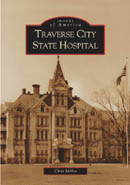Difference between revisions of "Arcadia Publishing"
Kirkbridian (talk | contribs) (→Napa State Hospital) |
Kirkbridian (talk | contribs) (→Northampton State Hospital) |
||
| Line 66: | Line 66: | ||
ISBN: 9781467122269<BR> | ISBN: 9781467122269<BR> | ||
On Sale Date: 10/27/2014<BR> | On Sale Date: 10/27/2014<BR> | ||
| − | [http://www.amazon.com/Northampton-State-Hospital-Images-America/dp/1467122262/ref=sr_1_1?ie=UTF8&qid=1441143880&sr=8-1&keywords=9781467122269]<BR> | + | [http://www.amazon.com/Northampton-State-Hospital-Images-America/dp/1467122262/ref=sr_1_1?ie=UTF8&qid=1441143880&sr=8-1&keywords=9781467122269 Purchase this book on Amazon]<BR> |
'''Book Description:''' Northampton State Hospital, established in 1856, was built with the optimistic spirit of humanitarian reform. For many years, it was run by Dr. Pliny Earle, a champion of treatment that combined individualized care with manual labor, religious worship, recreation, and amusement. This vision was overwhelmed as the hospital was called upon to care for ever-larger numbers of people with varying needs. By the mid-20th century, the hospital was an isolated small city, with hundreds of employees caring for more than 2,000 patients in overcrowded and inadequate conditions. It became a nationally important center of political and legal struggle over the role of state hospitals in the care of the mentally ill. After being gradually phased out, the hospital was closed in 1993, and the buildings, though listed in the National Register of Historic Places, were demolished in 2006. This volume brings to life the 135-year story of Northampton State Hospital through beautiful and haunting photographs drawn from the collections of Historic Northampton, the citys local history museum. | '''Book Description:''' Northampton State Hospital, established in 1856, was built with the optimistic spirit of humanitarian reform. For many years, it was run by Dr. Pliny Earle, a champion of treatment that combined individualized care with manual labor, religious worship, recreation, and amusement. This vision was overwhelmed as the hospital was called upon to care for ever-larger numbers of people with varying needs. By the mid-20th century, the hospital was an isolated small city, with hundreds of employees caring for more than 2,000 patients in overcrowded and inadequate conditions. It became a nationally important center of political and legal struggle over the role of state hospitals in the care of the mentally ill. After being gradually phased out, the hospital was closed in 1993, and the buildings, though listed in the National Register of Historic Places, were demolished in 2006. This volume brings to life the 135-year story of Northampton State Hospital through beautiful and haunting photographs drawn from the collections of Historic Northampton, the citys local history museum. | ||
Revision as of 15:14, 1 September 2015

Arcadia Publishing is best known for its iconic Images of America series, which chronicles the history of small towns, events, and specific topics across the country. Arcadia is home to a growing number to asylum related books, written by various authors. Below is a list of available asylum books from this publisher.
Contents
Byberry State Hospital

Author(s):Hannah Karena Jones
ISBN:9780738599083
On Sale Date:05/20/2013
Purchase this book on Amazon
Book Description: Looming on the outskirts of Philadelphia County since 1906, the mental hospital most commonly known as "Byberry" stood abandoned for 16 years before being demolished in 2006. At its peak in the 1960s, Byberry was home to more than 6,000 patients and employer to more than 800. With its own self-sustaining farm, bowling alleys, barbershop, ice cream parlor, federal post office, and baseball team, Byberry was a micro-community. Throughout its history, the hospital served as an educational institution for Philadelphia's medical, nursing, and psychology students; was the site of a World War II Civilian Public Service conscientious objector unit; and a volunteering hot spot for local churches, schools, and Girl and Boy Scout troops. This book provides an unprecedented window into the good, the bad, the unusual, and the forgotten history of Byberry.
Author Bio: Hannah Karena Jones holds dual bachelor's degrees in history and creative writing from Bloomsburg University of Pennsylvania and has presented her historical research at national Phi Alpha Theta and Collegiate Honors Council conferences. The images in this collection come from the Swarthmore College Peace Collection, Philadelphia City Archives, Pennsylvania State Archives, the Special Collections Research Center of the Temple University Libraries, the Library Company of Philadelphia, PhillyHistory.org, the Historical Society of Pennsylvania, and the personal collections of former staff members, among others.
Dixmont State Hospital

Author(s): Mark Berton
ISBN: 9780738545202
On Sale Date: 09/11/2006
Purchase this book on Amazon
Book Description: Pittsburgh natives have recognized Dixmont State Hospital by its towering boiler house smokestack that stood prominently along busy Route 65. It has been a topic of curiosity, urban exploration, ghost hunts, and historical research; but prior to its closing in 1984, Dixmont State Hospital stood as a refuge to the mentally ill for three counties in western Pennsylvania. A majestic study in the Kirkbride design of asylum architecture, Dixmont was originally built by the Western Pennsylvania Hospital in 1859 as a private venture before being bought by the commonwealth. It was named for famed mental health care reformer Dorothea Dix, who was instrumental in choosing the hospital’s site—a site chosen for its tranquility and its view of the Ohio River. Dixmont was completely razed in January 2006 to make way for a multi-parcel commercial endeavor. But for those who spent time there, Dixmont was a vibrant community within a community. Through historic photographs, Dixmont State Hospital opens up this world that was off limits to the general public but was alive with festivals, celebrations, and the successful treatment of patients.
Author Bio: Mark Berton covered Dixmont State Hospital for several years during his tenure with the Pittsburgh Tribune-Review, and he spends his free time photographing asylum architecture. His access to Dixmont and those who were part of its history provided a unique perspective in the life of a functioning mental health facility and its demise.
Eloise: Poorhouse, Farm, Asylum and Hospital 1839-1984

Author(s): Patricia Ibbotson
ISBN: 9780738519548
On Sale Date: 06/02/2002
Purchase this book on Amazon
Book Description: Eloise, which started out as a poorhouse, later became known as Wayne County General Hospital. From only 35 residents on 280 acres in 1839, the complex grew dramatically after the Civil War until the total land involved was 902 acres and the total number of patients was about 10,000. Today, all that remains are five buildings and a smokestack. Only one of them, the Kay Beard Building, is currently used. In Eloise: Poorhouse, Farm, Asylum, and Hospital, 1839-1984, this institution and medical center that cared for thousands of people over the years, is brought back to life. The book, in over 220 historic photographs, follows the facility's roots, from its beginnings as a poorhouse, to the founding of its psychiatric division and general hospital. The reader will also be able to trace the changing face of psychiatric care over the years. The book effectively captures what it was like to live, work, and play on Eloise's expansive grounds.
Author Bio: The author, Patricia Ibbotson, is a nurse, who worked at Eloise for over 23 years. She currently sits on the board of the Friends of Eloise, and she has been the editor of the Detroit Society for Genealogical Research Magazine for seven years.
Harrisburg State Hospital

Author(s): Phillip N. Thomas
ISBN: 9780738598277
On Sale Date: 03/11/2013
Purchase this book on Amazon
Book Description: Harrisburg State Hospital opened in 1851 as the Pennsylvania State Lunatic Hospital, the first public institution in the state. Situated atop a hill overlooking the Susquehanna River, the original building was an early example of a Kirkbride design hospital. The facility closed in 2006 after serving the commonwealth for 155 years. Harrisburg State Hospital: Pennsylvania's First Public Asylum presents a pictorial history of the hospital from the first year of only 12 patients through the peak of state care, when the population reached over 2,500 in the 1950s. Harrisburg State Hospital was an innovative leader in the treatment of the mentally ill, pioneering new methods of therapy even before they were common practice. It was a community and a home for those whom society could not otherwise care for.
Author Bio: Phillip N. Thomas discovered Harrisburg State Hospital in 2007 after taking up a hobby photographing abandoned buildings. After his visit, he would go on to create a website dedicated to the hospital, doing the same two years later for the state hospital in Danville. This book is his culmination of five years of research into the history of Harrisburg State Hospital.
Napa State Hospital

Author(s): Patricia Prestinary
ISBN: 9781467131995
On Sale Date: 09/08/2014
Purchase this book on Amazon
Book Description: Napa, because of its natural beauty and optimal conditions for moral treatment, was chosen as the second site for a state hospital to ease overcrowding in Stockton Asylum. When the fully self-sustaining Napa Asylum opened in 1875, it quickly filled to capacity and became home to many people suffering from mental illness, alcoholism, grief, and depression. In 1924, Napa Asylum was renamed Napa State Hospital to reflect changes in the medical model and treatments for psychiatric patients. Covering the first 100 years of the hospitals history, this unique book tells the story of the institution and the people for whom it served as employer. Known locally as Imola, this beautiful site became an integral part of the community.
Author Bio: Patricia Prestinary is a librarian and archivist who discovered the history of the Napa State Hospital through her volunteer work with the Napa Historical Society and Napap County Landmarks. The images in this collection come from the Napa Historical Society, California State Library, the Napa State Hospital, the Bancroft Library, and the personal collections of former staff members, amoung others.
Northampton State Hospital

Author(s): J. Michael Moore and Anna Schuleit Haber
ISBN: 9781467122269
On Sale Date: 10/27/2014
Purchase this book on Amazon
Book Description: Northampton State Hospital, established in 1856, was built with the optimistic spirit of humanitarian reform. For many years, it was run by Dr. Pliny Earle, a champion of treatment that combined individualized care with manual labor, religious worship, recreation, and amusement. This vision was overwhelmed as the hospital was called upon to care for ever-larger numbers of people with varying needs. By the mid-20th century, the hospital was an isolated small city, with hundreds of employees caring for more than 2,000 patients in overcrowded and inadequate conditions. It became a nationally important center of political and legal struggle over the role of state hospitals in the care of the mentally ill. After being gradually phased out, the hospital was closed in 1993, and the buildings, though listed in the National Register of Historic Places, were demolished in 2006. This volume brings to life the 135-year story of Northampton State Hospital through beautiful and haunting photographs drawn from the collections of Historic Northampton, the citys local history museum.
Author Bio: Historian J. Michael Moore is the author of The Life and Death of Northampton State Hospital, based on extensive interviews with workers and clients. Visual artist Anna Schuleit Haber created the sound installation Habeas Corpus, in which the abandoned architecture was turned into an instrument in a single performance of J.S. Bach's Magnificat.
Oakdale: The Lapeer State Home

Author(s): Laura Fromwiller and Jan Gillis
ISBN: 9781467112437
On Sale Date: 08/04/2014
[1]
Book Description: The Lapeer State Home has been a large part of the history of Lapeer County since it beginning in 1895. After start with three buildings and housing for 200 patients, the facility grew to encompass several hundred acres and at its peak, accommodating over 4,000 patients. The history of the home includes a variety of memories from staff members, patients, and visitors who once walked its halls. Images of America: Oakdale: The Lapeer State Home provides a journey of this historic institution and attempts to bring some clarity to questions that remain about the home and its past.
Author Bio: Laura Fromweller and Jan Gillis are Lapeer County residents who work at the historic Marquette deAngeli Library in Lapeer and have researched the Lapeer State Home for over 15 years. This book contains a compilation of materials and photographs that the authors have gathered, from community members and other sources, for the library's collection. Fromweller has a master's degree in litrary and information science from Wayne State University, and Gillis has a baccalaureate in communications form the University of Washington.
Oregon Asylum

Author(s): Diane L. Goeres-Gardner
ISBN: 9780738599885
On Sale Date: 06/17/2013
Purchase this book on Amazon
Book Description: The Oregon State Insane Asylum was opened in Salem on October 23, 1883, and is one of the oldest continuously operated mental hospitals on the West Coast. In 1913, the name was changed to the Oregon State Hospital (OSH). The history of OSH parallels the development and growth in psychiatric knowledge throughout the United States. Oregon was active in the field of electroshock treatments, lobotomies, and eugenics. At one point, in 1959, there were more than 3,600 patients living on the campus. The Oscar-winning movie One Flew Over the Cuckoo's Nest was filmed inside the hospital in 1972. In 2008, the entire campus was added to the National Register of Historic Places, and the state began a $360-million restoration project to bring the hospital to modern standards. The story of OSH is one of intrigue, scandal, recovery, and hope.
Author Bio: Historian J. Michael Moore is the author of The Life and Death of Northampton State Hospital, based on extensive interviews with workers and client. Visual artist Anna Schuleit Haber created the sound installation Habeas Corpus, in which the abandoned architecture was turned into an instrument in a single performance of J. S. Bach's Magniicat.
Spring Grove State Hospital

Author(s): David S. Helsel M.D., Trevor J. Blank
ISBN: 9780738553269
On Sale Date: 02/25/2008
Purchase this book on Amazon
Book Description: Founded in 1797, Spring Grove State Hospital, now known as Spring Grove Hospital Center, is the second oldest continuously operating state psychiatric hospital in the country. This volume will reveal through a broad array of poignant historic images the extensive, complex, and fascinating history of Maryland’s oldest hospital. Included are interior and exterior photographs of many of the hospital’s historic buildings, as well as depictions of daily life at the hospital during a bygone era. The institution’s historic pedigree includes its role as a hospital for soldiers and sailors wounded in the Battle of North Point during the War of 1812, and Spring Grove’s Main Building may have been used to quarter soldiers during the Civil War. Once a largely self-contained asylum, Spring Grove’s history is closely tied to the crusader Dorothea Dix, as well as to many more recent treatment advances.
Author Bio: Psychiatrist David S. Helsel, M.D., serves as the current superintendent of Spring Grove Hospital Center. Trevor J. Blank is a graduate student at Indiana University’s Folklore Institute and is the founder of the Hillcrest Historical Society, a Baltimore County historic preservation group that worked to save Spring Grove’s former maximum-security building.
Traverse City State Hospital

Author(s): Chris Miller
ISBN: 9780738533896
On Sale Date: 05/02/2005
Purchase this book on Amazon
Book Description: Northern Michigan Asylum, which opened in 1885, was known during most of its years as Traverse City State Hospital. It was run during its first decades by Dr. James Decker Munson, who left his legacy in the landscaped grounds and the medical center that today bears his name. Traverse City State Hospital served the mental health needs of a large part of Michigan for 104 years until its closure in 1989, housing a population as large as 3,000 in its many buildings.This book traces the history of this great institution, from the local and mental health context in which it was founded, through its growth, development, and decline, and finally to its renovation and preservation as a vital part of the Traverse City community. More than 200 photographs and images are provided, including many of the features and buildings long gone.
Author Bio: Author Chris Miller was active as a member of the Committee to Preserve Building 50, one of the community groups that arose to save the historic and natural features of the former Traverse City State Hospital grounds when they were threatened at the end of the 1990s. He is the author of Winona in Vintage Postcards, also available from Arcadia Publishing.